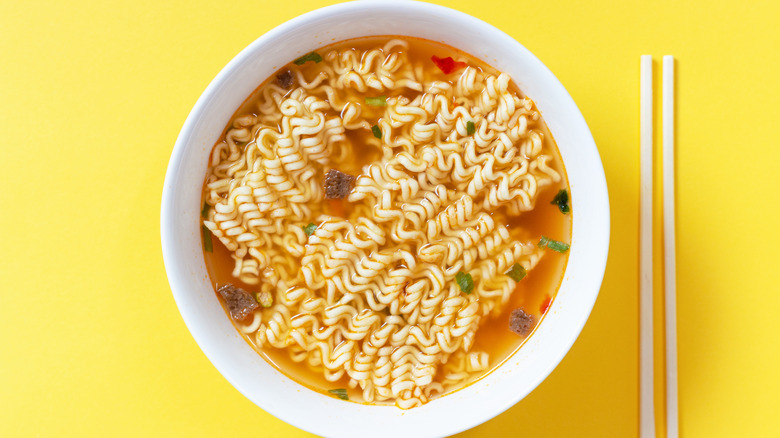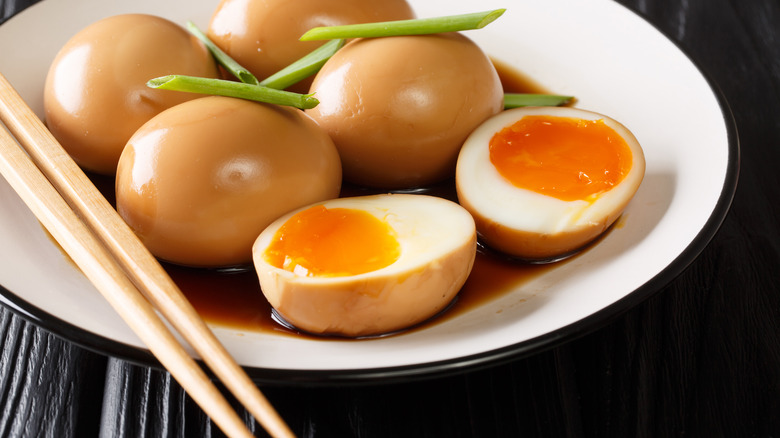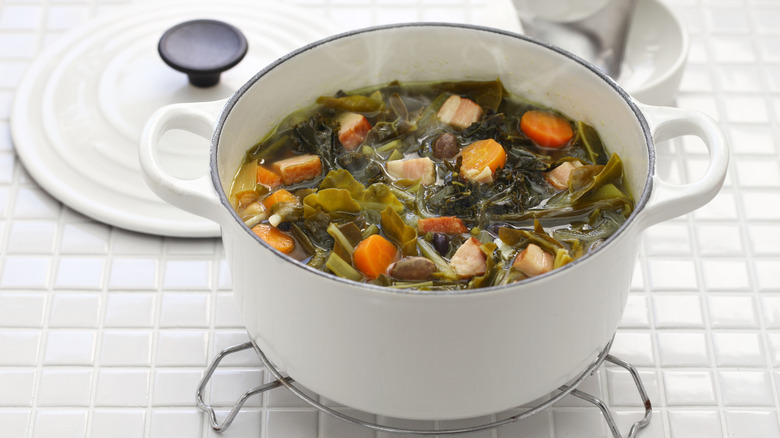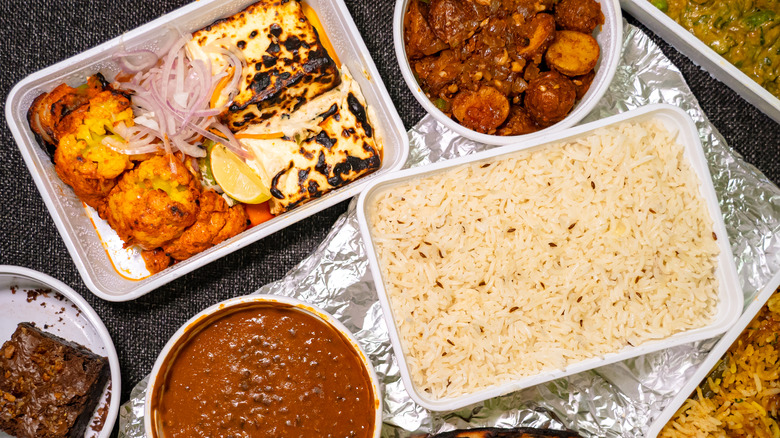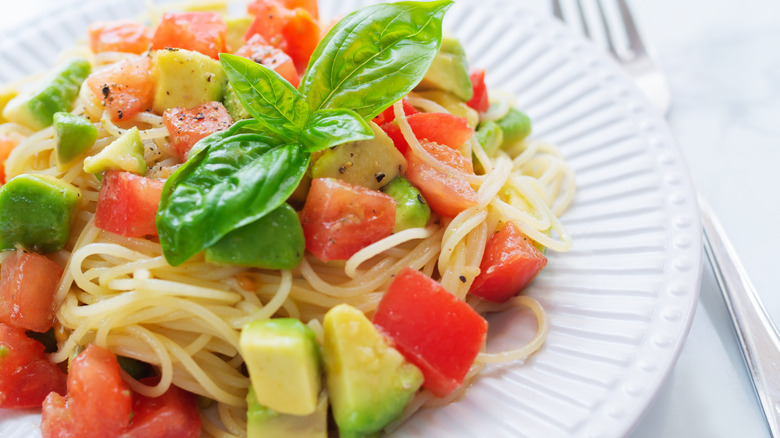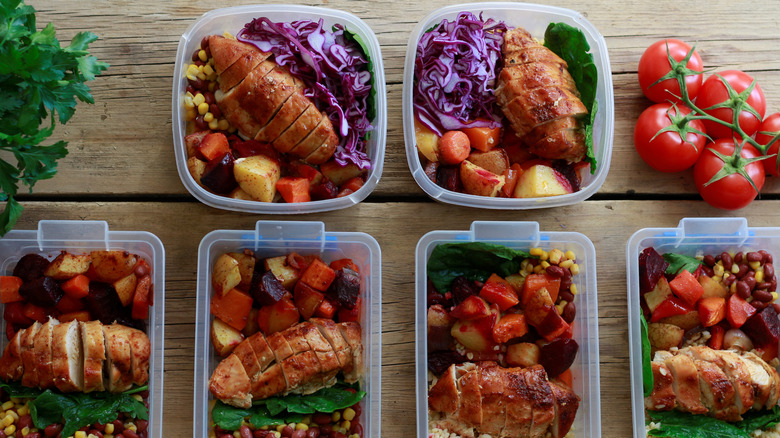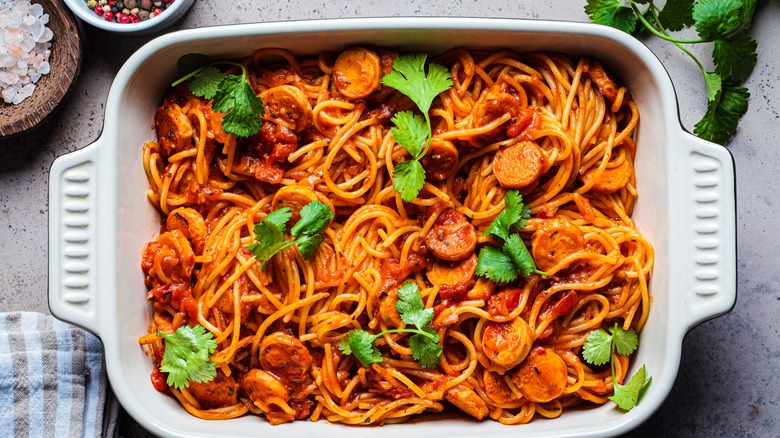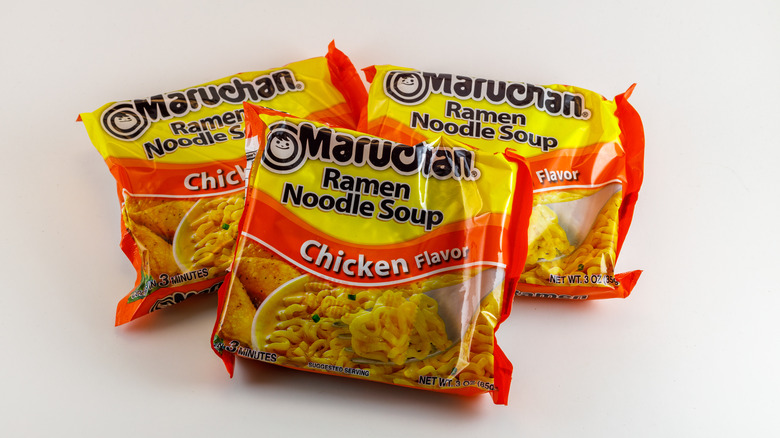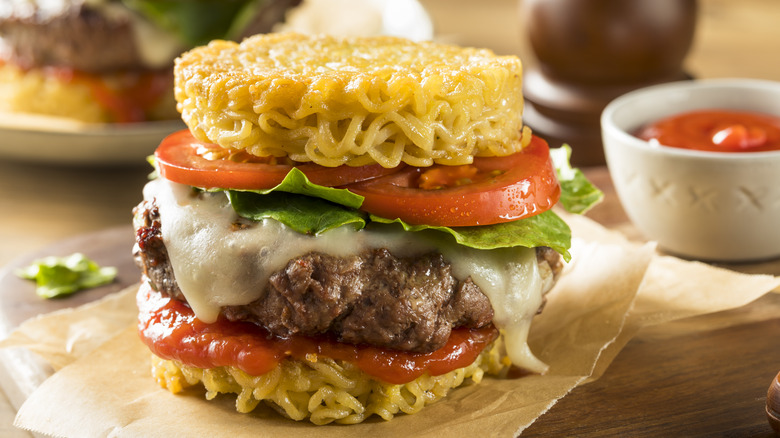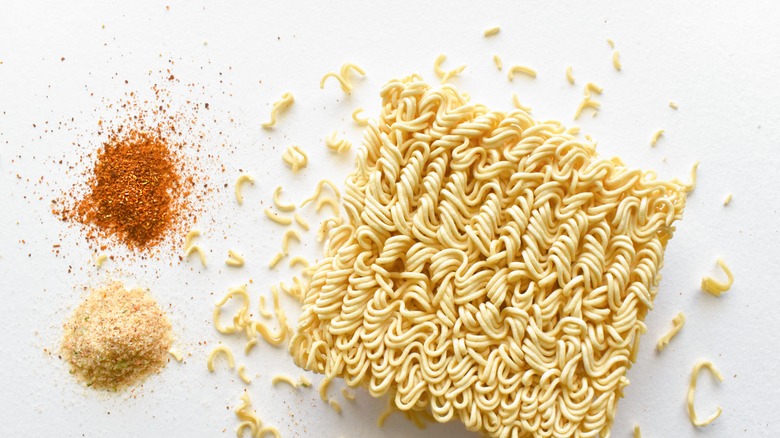11 Clever Ways To Use Ramen Noodles
Ramen, a traditionally Japanese dish, spans different flavor combinations, styles, and even price ranges depending on where you find it. Luckily, you don't have to live in Japan to enjoy ramen, as instant ramen noodle brands of different flavors and nationalities can be found almost anywhere. And with online marketplaces like Amazon, you can choose from an even wider assortment of tastes and styles from countries across the world.
The most common form of ramen noodles involves two main components, the ramen and the broth (three if you include the extra toppings), both of which can be customized and enhanced by simple additions or replacements. Instant ramen especially is perfect for this, as it tends to be simplistic in nature, making it the perfect dish for trying new combinations of flavors and ingredients. This ability to customize is one of the reasons ramen is so popular throughout the world, even to the point where there are 14 different regional flavors of broth just within Japan. However, the simplicity of instant ramen and its components also make it multipurpose, going beyond just soup and broth. From bringing some fun to flavorful leftovers to creating something completely new and different, ramen can be more than just a brick of dried noodles and a salty packet of seasoning.
1. Have noodles for breakfast
For restaurant-goers who go for the more artisanal ramen dishes, eggs and noodles are a fairly common combination. Originally, eggs could be found added into ramen raw or hard boiled for additional flavor and protein. However, soft-boiled ramen eggs, a trend started by the ramen restaurant Chibakiya in Tokyo, has taken the world by storm and become a global standard. The egg-and-ramen pairing also exists abroad, including in Korean ramyeon dishes, which often include eggs as a topping or ingredient added during cooking. For those who love eggs and are looking to go beyond traditional ramen shop recipes, there are plenty of ways to upgrade your egg game.
One way to innovate on eggs in ramen is to apply that creativity to the egg itself. Start with marinating the eggs in seasoned soy sauce after soft-boiling them, creating a dish that's often called ajitama. The marinade gives the eggs an essential umami flavor which complexifies the ramen itself. To change up a traditional ramen recipe, try bringing together another classic pairing — bacon and eggs. A bowl of bacon and egg ramen brings the savoriness of the bacon into the soothing, rich ramen broth, enhanced by egg- and-bacon flavored noodles.
To go further past the envelope is to rethink the combination of ramen noodles and eggs — by bringing ramen into the egg's environment. Try scrambling eggs with a wad of cooked ramen noodles, covered in cheese and your favorite seasonings for eggs. Or in a non-broth bowl of seasoned noodles, top the dish with a fried or over-easy egg for added texture and protein.
2. Use up your fridge stock in a leftover ramen soup
At the end of the week, a fridge full of leftovers can sometimes feel daunting to deal with, as well as a bit tiring since you're eating something you've already had that week. One way to beat these leftover blues is to bring another layer of flavor or intrigue — by throwing it into a pot of broth and calling it soup. Tossing in some cooked ramen noodles makes it a delicious ramen meal.
For example, a large pile of leftover roasted vegetables can give you enough to make a bowl of roasted vegetable ramen. Raw elements work great as well, especially with partially used vegetables like onion, carrots, or celery that can sometimes go bad if you don't get the chance to use them.
Protein helps bulk up ramen dishes traditionally, so a lot of leftover meats work great. The remnants of a package of fried or rotisserie chicken, for example, can become a delicious pot of chicken ramen for dinner. Equally as important to keep in mind, though, is cooking the noodles. There are ways of making sure the ramen and soup work cohesively together, based on the techniques used to cook the noodles. Some methods include cooking the noodles in water separately before adding them to the soup to prevent a waxy texture, or letting the noodles cook without touching them to ensure they don't turn soggy.
3. Extend your Indian takeout
As mentioned, the presence of ramen and instant ramen has spread far across the world, with countries developing their own signature recipes for seasonings and variations on preparing the dishes. For example, brands of instant ramen sold in different countries tend to replicate flavors in traditional dishes, such as the star anise in Chinese five spice or the bright and spicy seasonings in Thai-style tom yum soup. In India, many brands offer masala-flavored seasonings, as the rich spices that go into many traditional Indian recipes pair well with the base noodles in a brothy, curry-like consistency. For those who love Indian food and traditional dishes like chicken curry, aloo gobi, and tikka masala, utilizing a standard packet of ramen the next time you order out can make the most of your takeout experience.
Apart from standard instant ramen, there are some Indian dishes that incorporate noodles of a similar style and thickness. Certain regions in India make what's known as idiyappam, which usually includes rice flour and coconut as ingredients and is served with curries. Its ability to withstand the heavy sauces and soak them up elongates the flavor experience in a fun way. Similarly, you can pair regular ramen packs, sans seasoning, with your favorite Indian curries or saucier dishes. This works great for fresh or even leftover Indian food.
4. Trade in your regular pasta with ramen in a pinch
Delicious Italian meals can sometimes rely on equally indulgent ingredients in recipes, from white truffles and prawns to certain varieties of meats and cheeses. However, no matter the decadence of ingredients added to it, pasta is an often cheap, basic staple that makes any Italian meal feel elevated. If you're out of traditional pastas and don't feel like running to the store, a quick and delicious way of making pasta easier and faster is opting for ramen instead.
This substitution can be as easy or as complex as you like it. Having a fix for homemade meat sauce or ragù? Pile some onto a serving of cooked ramen. Broken up into small pieces, you can treat ramen similar to an orzo or acini pepe and cook in chicken broth and butter with some cheese. For a true classic, there are even ways of going all out with a ramen-based carbonara, resulting in a cheesy, creamy noodle fest.
Italian isn't the only avenue to go down, either. Classic recipes like chicken noodle soup can be adjusted to use broken up ramen pieces as the noodles instead of typical egg noodles or otherwise. Variations are welcomed in recipes like this, such as a lemon chicken ramen soup.
5. Use cold leftover noodles in new ways
A clever way to rethink the use of ramen is to rethink pasta dishes overall. The beauty of many pasta dishes is serving them hot, with the flavor of the sauce, broth, and other ingredients reacting with the heat. There is, however, a multitude of cold noodle recipes that make excellent dishes to add into your weekly repertoire. There is much to love about cold noodle recipes, from how easy they are to put together to the use of fresh produce, which is great during the summertime. A cold summer ramen combines typical Asian elements, such as dashi stock, white miso, and bonito flakes, with succulent summer vegetables that keep things both light and filling.
Typically, cold noodle salads like macaroni or pasta salad coincide with dishes made during warmer weather months and show up at cookouts and picnics. Ramen can work in a cold noodle salad, too. With fresh vegetables and savory additives like cooked chicken, you can experiment with flavorings and put your own spin on recipes.
6. Try out ramen with your meal prep
The range of meal prep recipes available is wide and diverse, from casseroles and quiches to slow-cooker chickens and stews that take little effort. There are even some that only require you to package the ingredients in a cooking vessel, such as a mug or mason jar. The crux of good meal prep recipes relies on being simple and easy to make, as well as the ability to customize ingredients and flavors. A leader in flexibility and versatility, ramen noodles are a great meal prep additive — like an upgraded noodle cup.
For meal-prepping your own ramen cups, it is best to think ahead about your favorite toppings in ramen, including spices and flavors. These elements should go into your vessel of choice before the ramen itself, seasonings first and then additives or toppings. Great additives include frozen vegetables and protein like leftover cooked chicken or even tofu. The ramen comes next and should be cooked before adding, making reheating easy. Rice noodles are another good option, but ramen is usually more accessible.
7. Bake your ramen for fun family-sized meals
More often than not, leftover pasta that isn't used ends up sitting too long in the fridge, which can affect its taste and texture. A great way to use up that pasta is to feature it in a baked dish, as the texture will help hold together thick sauces and cheeses cohesively when cooked in the oven. Baking pasta is a common practice for those who enjoy family-sized meals, and, while it isn't a typical way to make ramen, there are plenty of ways to use ramen in a similar fashion.
One interesting way to use ramen's structure and texture in baking is to make a shepherd's pie, where the typical top layer of mashed potatoes is exchanged for a pile of buttery, cheesy ramen noodles. The crevices in the noodles will catch different levels of heat, similar to the classic layer of potatoes, resulting in a crunchy, extra cheesy topping. Leftover spaghetti, like ramen, bakes well in both large dishes and small ones. One trick is to use the small spaces of a muffin pan with the small portions of ramen, creating a baked ramen nest which can be an excellent vessel for meatballs, making for a great appetizer.
8. Fried ramen for a crunchy addition
When it comes to snacks, the mission isn't always to grab something healthy — just something delicious and satisfying, especially in a small, bite-sized form. Many snacks thought to be healthy actually aren't, from granola bars and trail mix to even bottled fruit smoothies. Though not necessarily the healthiest in their fully cooked form, ramen noodles broken up and fried in small pieces add a tasty crunch to recipes that can benefit from another textural element.
These pieces can help differentiate the mouthfeel of the snack, such as in an updated version of Wolfgang Puck's Asian-inspired chicken salad that includes fried ramen bits. They can also merely top dishes as a garnish, like a bowl of sesame noodles with fried ramen instead of chopped up peanuts. You can even mix the ramen pieces into the standard seasoning packet to give them a light coating for extra flavor.
9. Rethink ramen as ... bread?
It might sound strange, or even impossible, but we assure you it's not. Utilizing ramen as you would bread not only can be done but is a fun use of the noodles that can change up even the most classic recipes.
Just like ramen, bread comes in many forms. One of the tastiest uses of bread are with sandwiches, or even burgers and hot dogs. By cooking the ramen first and incorporating binding ingredients like eggs, you can form the ramen into flat disks and bake or fry in order to serve ramen burgers. You can make larger disks for big, custom burgers or smaller rounds for meatballs or sliders. Not to mention the fact that you can use the salty, umami flavor of the seasoning packet in the burgers or on the chicken between the buns.
Ramen as bread can also go beyond the bun: It can be broken down into a breadcrumb or flour consistency in order to dredge meat in for fried chicken. Because ramen noodles are already cooked before they are packaged, you can break them down into a powder by using a high-powered blender or even a spice grinder. You can then choose to use the seasoning packet for added ramen-type flavor, or use your own blend of spices.
10. The sweet possibilities of dessert ramen
There are actual scientific reasons as to why ramen noodles are not only delicious but also unique. The texture of ramen is due to the noodles' four basic ingredients: wheat flour, water, salt, and kansui, which is essentially an alkaline mineral water. When mixed with the wheat flour, kansui gives the noodles a springy shape and a texture that is firm with a slight chew, though still slippery. That texture also can work for turning what is normally a savory dish into a sweet treat.
As we've previously noted, ramen can be formed into bread-like creations. In its cooked form, the slippery yet springy texture of ramen makes for a good main ingredient for a waffle. Cooking the noodles and compressing them in a waffle maker will give you a ramen waffle. This treat can be seasoned for savory specialties like fried chicken and waffles — but also sweet treats with maple syrup, brown sugar, cinnamon sugar, and even caramel and ice cream.
Another potential sweet use of ramen starts with keeping the noodles in their dry form — and covering them in chocolate. The alkaline mineral water that makes ramen unique does even more for other foods as well; it's responsible for Oreos' classic chocolatey taste, pretzels' brown exteriors, and more. Keeping the noodles dry and drizzling or covering them in chocolate gives the same savory and sweet combination as chocolate-covered pretzels. You can separate the ramen brick into large or small pieces and add whichever type of chocolate you prefer.
11. Seasonings count, too
Finding ways to utilize a packet of ramen also means using every aspect of the item — including the seasonings. Particularly in the U.S., ramen noodles are known for featuring salty seasoning packets that give each individual flavor variety its distinctive taste. However, the sodium included in a packet of ramen is very high – 88% of the daily recommended amount suggested by the World Health Organization. Nonetheless, this packet of spices can be used for more than just noodles.
Because of the umami richness and salt presence, ramen seasonings can be great additives for meals that need a boost in their specific flavor. The chicken-flavored ramen seasoning works great in the flour used for fried chicken, for instance, or perhaps you could give a beef and barley soup some added beefy taste with a beef packet, similar to how you would use a bouillon cube. Of course, some of the best dishes to sprinkle these seasonings on would naturally be snacks or dishes that need salt. Popcorn is a great snack to try this with, as the popped kernels themselves are basic in flavor and usually require butter and salt to give them a satisfying taste.
Experimenting typically leads to unique finds and results. One Reddit user says sprinkling the seasoning on some hot rice will flavor it without using a lot of ingredients, something you could easily do with potatoes as well. You'll never truly know unless you try.
Static Media owns and operates Daily Meal and Tasting Table.
